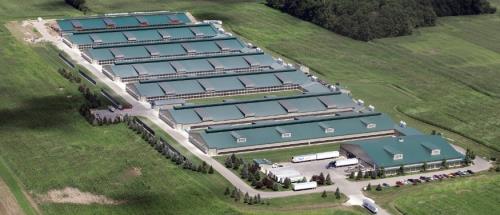|
The initial phase of conversion from conventional cages to aviary units in the 2010s involved reconstruction and modification of existing high-rise houses to accommodate aviaries or in some cases floor systems. Building restrictions, farm layout, house dimensions and design dictated decisions on equipment, ventilation and services.
|
 Midwest Complex Representing the ultimate in professional planning and execution Midwest Complex Representing the ultimate in professional planning and execution |
Establishing a green-field complex to accommodate two million hens is a far more complex endeavor requiring not only technical input from qualified engineers and production specialists but coordination of the various disciplines to achieve an optimal outcome. Where owners of laying operations could serve as their own general contractors in the 1990s the complexity of a project comprising nine or more multi-level aviary houses each holding more than 300,000 hens requires a competent general contractor with deep resources and experience.
The initial and critical step in a project is to prepare a comprehensive feasibility study, required in any event by financial institutions. This key planning document takes into account a realistic market forecast that should determine the size of the intended complex, production and packing parameters, capital and operating cost and a projection of return on investment.
Lenders are now disinclined to advance funds for projects in excess of $100 million without assurances that recipients have the capacity to service loans. Collateral represented by a completed in-line project can only be used for egg production. In a market depressed by prolonged overproduction, the value of capital assets to produce eggs would be heavily discounted in the event of a default.
It is a valid observation that some projects are conceived in isolation without reference to the activities of competitors. This is partly the reason why our industry has traditionally undergone wide swings in profitability, attributed to cycles of overproduction relative to demand. To paraphrase the late Vice President Hubert Humphrey, a few million additional hens here and there soon adds up to real volume.
Conceptual planning must take into account the ultimate size of a complex including feed production, packing and further processing in addition to the facilities for pullet rearing, laying hens, biosecurity and services. In recent years, complexes have been erected without adequate biosecurity or with unbalanced capacities for rearing and laying that detract from optimal utilization of capital intensive facilities. Neglecting biosecurity can result in complete depopulation in the event of exposure to a catastrophic disease or at best a severe impact on production and profit following introduction of an erosive infection such as coryza. Inadequate capacity to rear pullets may require purchase of pullets or alternatively houses may stand idle while they incur fixed costs including interest and depreciation.
Professional input is required to design multi-level structures to ensure they are able to withstand floor loading, wind forces, extreme heat or snow accumulation depending on location. Over-design is expensive but under-design can be catastrophic. Structures and equipment are becoming more complex requiring the input of electrical engineers and suppliers experienced in installing computerized sensor and control equipment to monitor and manage flocks. Although there are many efficient component systems available to control ventilation, to ensure regular egg flow to the packing plant and to monitor flock performance it is necessary that systems be compatible and coordinated with respect to their function. This requires consultation among management, equipment suppliers and professional consultants.
Compliance with environmental restraints, welfare mandates, state and local regulations including building and fire codes must be incorporated into planning and permitting. Erection of a complex representing a continuum from breaking ground to completion requires coordination, applying modern project-management technology. Delays in delivery of imported or critical components can impact progress and distort completion schedules, requiring appropriate modification. Compromises involving the inherent biological cycle of rearing and egg production can have profound financial impacts if flocks are transferred prematurely or if older flocks are retained beyond their productive and economic life.
Committing upwards of $100 million to a complex requires a level of professionalism commensurate with the magnitude of the investment. Traditional approaches to building single-level, high-rise complexes of the 1990's are no longer valid. Capital cost and complexity have increased at a rate requiring a high degree of professional involvement. We have seen too many new buildings engulfed in flames due to substandard electrical installations. Disease outbreaks that have occurred in recent years can be contributed to defects in both structural and operational biosecurity. The return on investment in many operations is less than optimal due to deficiencies in planning and execution.
It is always more expensive to modify and redesign after completion of a project compared to the return from professional planning and execution - just ask Boeing.